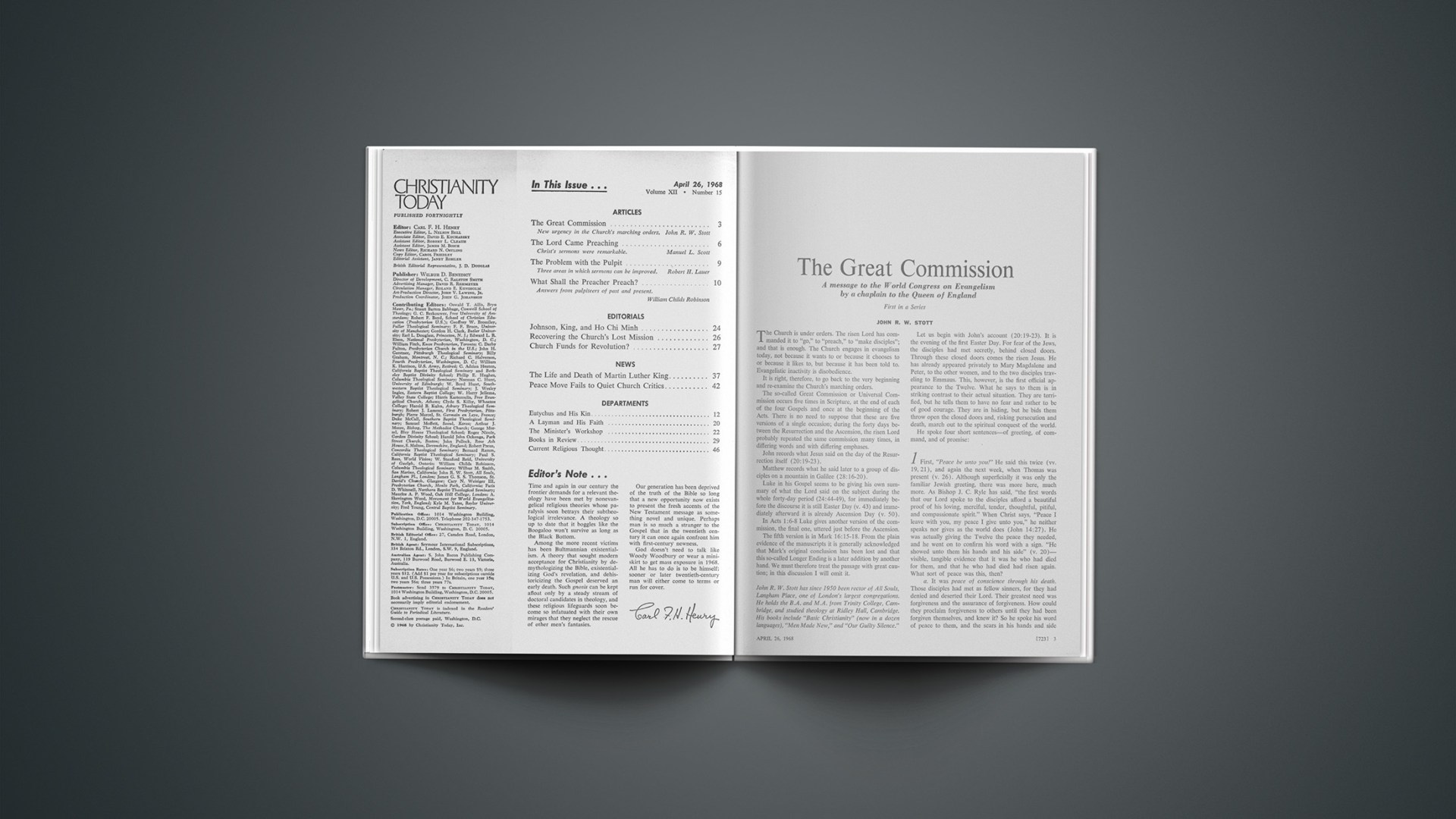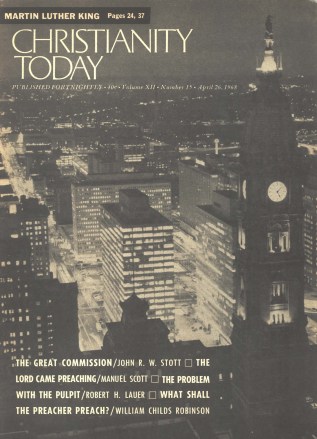A message to the World Congress on Evangelism by a chaplain to the Queen of England
First in a Series
The Church is under orders. The risen Lord has commanded it to “go,” to “preach,” to “make disciples”; and that is enough. The Church engages in evangelism today, not because it wants to or because it chooses to or because it likes to, but because it has been told to. Evangelistic inactivity is disobedience.
It is right, therefore, to go back to the very beginning and re-examine the Church’s marching orders.
The so-called Great Commission or Universal Commission occurs five times in Scripture, at the end of each of the four Gospels and once at the beginning of the Acts. There is no need to suppose that these are five versions of a single occasion; during the forty days between the Resurrection and the Ascension, the risen Lord probably repeated the same commission many times, in differing words and with differing emphases.
John records what Jesus said on the day of the Resurrection itself (20:19–23).
Matthew records what he said later to a group of disciples on a mountain in Galilee (28:16–20).
Luke in his Gospel seems to be giving his own summary of what the Lord said on the subject during the whole forty-day period (24:44–49), for immediately before the discourse it is still Easter Day (v. 43) and immediately afterward it is already Ascension Day (v. 50).
In Acts 1:6–8 Luke gives another version of the commission, the final one, uttered just before the Ascension.
The fifth version is in Mark 16:15–18. From the plain evidence of the manuscripts it is generally acknowledged that Mark’s original conclusion has been lost and that this so-called Longer Ending is a later addition by another hand. We must therefore treat the passage with great caution; in this discussion I will omit it.
Let us begin with John’s account (20:19–23). It is the evening of the first Easter Day. For fear of the Jews, the disciples had met secretly, behind closed doors. Through these closed doors comes the risen Jesus. He has already appeared privately to Mary Magdalene and Peter, to the other women, and to the two disciples traveling to Emmaus. This, however, is the first official appearance to the Twelve. What he says to them is in striking contrast to their actual situation. They are terrified, but he tells them to have no fear and rather to be of good courage. They are in hiding, but he bids them throw open the closed doors and, risking persecution and death, march out to the spiritual conquest of the world.
He spoke four short sentences—of greeting, of command, and of promise:
1 First, “Peace be unto you!” He said this twice (vv. 19, 21), and again the next week, when Thomas was present (v. 26). Although superficially it was only the familiar Jewish greeting, there was more here, much more. As Bishop J. C. Ryle has said, “the first words that our Lord spoke to the disciples afford a beautiful proof of his loving, merciful, tender, thoughtful, pitiful, and compassionate spirit.” When Christ says, “Peace I leave with you, my peace I give unto you,” he neither speaks nor gives as the world does (John 14:27). He was actually giving the Twelve the peace they needed, and he went on to confirm his word with a sign. “He showed unto them his hands and his side” (v. 20)—visible, tangible evidence that it was he who had died for them, and that he who had died had risen again. What sort of peace was this, then?
a. It was peace of conscience through his death. Those disciples had met as fellow sinners, for they had denied and deserted their Lord. Their greatest need was forgiveness and the assurance of forgiveness. How could they proclaim forgiveness to others until they had been forgiven themselves, and knew it? So he spoke his word of peace to them, and the scars in his hands and side were evidence (however dimly they understood it) that he who promised them peace had actually “made peace through the blood of his cross” (Col. 1:20). His death had an abiding significance; he still carried its marks in his body.
Our first need, too, before we can begin to evangelize, is the forgiveness of our sins and the assurance of forgiveness. And the risen Christ still speaks peace to the conscience of his people, still confirms his word with a sign. Are not the bread and wine of Communion today what the hands and sides of Jesus were on that day? They are visible, tangible tokens that he loved us and gave himself for us.
b. The peace Christ gave was also peace of mind through his resurrection. The disciples who gathered in that room on the first Easter Day were one in doubt as well as in sin. Even though the Lord had repeatedly predicted his death, it took them by surprise. They had not expected it. How could Jesus be the Messiah if he had ended his days on a cross, on an accursed tree? Their faith lay in dishevelment; their minds were in turmoil.
So the “peace” Jesus spoke and the sign he gave were for the mind as well as for the conscience. His wounded hands and side were evidence not only that he had died but that he had risen, and that the One who had risen was the same One who had died. “Then were the disciples glad, when they saw the Lord” (v. 20). It was the same for Thomas a week later. Great is our joy when the bright light of the Resurrection shines into the dark corners of our doubt.
The Church’s very first need, then, before it can begin to engage in evangelism, is an experience and an assurance of Christ’s peace—peace of conscience through his death that banishes sin, peace of mind through his resurrection that banishes doubt. Jesus repeated his greeting for emphasis: “Peace be unto you.” We cannot preach the Gospel of peace to others unless we ourselves have peace. Indeed, the greatest single reason for the Church’s evangelistic disobedience centers in its doubts. We are not sure that our own sins are forgiven. We are not sure that the Gospel is true. And so, because we doubt, we are dumb. We need to hear again Christ’s word of peace, to see again his hands and his side. Once we are glad that we have seen the Lord, and once we have clearly recognized him as our crucified and risen Saviour, then nothing and no one will be able to silence us.
2“As my Father hath sent me, even so send 1 you” (v. 21). Although this is the simplest form of the Great Commission, it is at the same time the most profound form, the most challenging, and therefore the most neglected.
In these words Jesus gave not only a command to evangelize (“the Father sent; I send you”) but also a pattern (“As the Father sent me, so send I you”). The Church’s mission in the world is like Christ’s. He was the first missionary, and all our mission is derived from his.
How did the Father send the Son? Here are three answers:
a. The sending involved birth into the world. The Son did not stay in heaven; he was sent into the world. Nor did he come into the world in the full regalia of his divinity. He laid aside his glory. He became poor. He did not come in human disguise; he actually took our nature and was born into the world.
b. The sending involved life in the world. Having assumed man’s nature, the Son shared man’s experience. Once “the Word was made flesh,” he “dwelt among us” (John 1:14). He exposed himself to temptation, sorrow, loneliness, opposition, scorn. He mixed freely with men, even in sinful, secular society. He was criticized for fraternizing with publicans and sinners. “This man receives sinners and eats with them!” men sneered. Indeed he did. It is our boast: one of his most honorable titles is “friend of publicans and sinners” (e.g., Matt. 11:19).
c. The sending involved death for the world. God’s Son did more than just take upon himself man’s nature and life; he assumed man’s sin as well. If he was “made flesh,” he was also “made sin” and “made a curse” (John 1:14; 2 Cor. 5:21; Gal. 3:13). Of course, the sin-bearing death of Jesus in its atoning significance and power was absolutely unique. Yet in a secondary sense we too are called to die, to die for the very people we seek to serve. Not until the seed dies is the fruit borne. “The disciple is not above his master.… If any man serve me, let him follow me.… If any man will come after me, let him deny himself, and take up his cross daily, and follow me” (see John 12:24–26; Luke 9:23). We must be ready to lay down our lives for others, not only in martyrdom but also in self-denying service—to be despised and rejected sometimes in the living death of misunderstanding, misrepresentation, ridicule, and obscurity.
By his birth, by his life, and by his death, then, God’s Son identified himself with man. He did not stay aloof; he made himself one with us. All this was involved in his being sent by the Father into the world.
Now he says to us, “As the Father sent me into the world, so send I you.” Failure to obey the implications of this seems to me to be our greatest weakness in evangelism today. We do not identify. We shout advice to drowning men from the safety of the shore; we do not dive in to rescue them. But Jesus Christ did not broadcast salvation from the sky. He visited us in great humility.
Our hesitancy is somewhat understandable. It derives partly from our sharp reaction against those who lay such stress on identification that they have renounced the duty to proclaim the Gospel. “We must sit down beside these unbelievers,” they say, and they are quite right. But they wrongly continue: “We have nothing to say to them. We must listen to them. We must let them teach us.”
By all means we must be ready to listen and learn; and we must also be ready to speak. Evangelism modeled on the ministry of Jesus is neither proclamation without identification nor identification without proclamation. It is both together. Jesus Christ is the Word of God, the proclamation of God; in order to be proclaimed, however, the Word was made flesh.
Frankly, this is my own greatest problem as a parish minister. I love to preach the Gospel—to those who will listen to it. No ministerial activity brings me greater joy than the exposition of God’s Word to those believers and unbelievers who come to church to hear it. But how am I to identify with the people of the parish who will not hear? How can I become one with secular men and women, as Christ became one with us, so that I can express and demonstrate my love for them and win a right to share with them the good news of Christ? I cannot be content to shout the Gospel at them from a remote and sheltered vantage point; I want to become their friend and argue it out with them side by side. I want to witness to Christ in their very midst. Just how to do this is an urgent question for those who want to follow in the footsteps of the Master.
3“Receive ye the Holy Ghost” (v. 22). These verses have a trinitarian framework: the Church’s mission is modeled on the Father’s sending of the Son and empowered by the Son’s sending of the Spirit.
I do not think that Jesus gave these disciples a special gift of the Spirit at that moment. His teaching about the Spirit, both in the upper room and during the forty days, suggests rather that here we have a dramatic anticipation of Pentecost, when he would pour out the Spirit upon them and endue them with power for their evangelistic task. He repeatedly promised this to them during the forty days, and here he breathed on them to confirm his promise with a sign. Just as before his death, in anticipation of it, he gave them broken bread, saying, “Take, eat, this is my body,” so before his outpouring of the Spirit he breathed on them and said, “Receive the Holy Spirit.” Just as he enforced his word of peace by showing them his hands and his side, so he enforced his promise of the Spirit by breathing on them. After this experience they could never separate the Spirit from the Son. He had actually breathed on them. They knew the Spirit was his gift, the Holy Breath of Jesus Christ himself.
4 But the Church needs more than power; it needs a message. To this the Lord says: “Whosesoever sins ye remit, they are remitted unto them; and whosesoever sins ye retain, they are retained” (v. 23). Upon these controversial words (with the words in Matthew 16:19 and 18:18 about binding and loosing) the Roman Catholic Church has built its rigid structure of sacramental confession and priestly absolution. But we deny this interpretation by applying to Christ’s words the two most basic principles of biblical interpretation. A text can never be interpreted in isolation; it must be viewed in its double context, that is, in both its historical and its biblical setting.
a. The historical context. In trying to understand a text we must ask what the speaker meant by it and what his hearers understood by it. We must be careful not to read into it alien ideas of a later age. What, then, did the apostles understand by this statement about the remission and the retention of sins?
That they did not imagine they were being given priestly or judicial authority to forgive sins is abundantly plain from the fact that later they neither claimed nor exercised such powers. Never in the Acts or the epistles did an apostle (or anybody else) require the private confession of sins or grant absolution to sinners.
What the apostles did, and did constantly, was preach the Gospel, declaring with authority the terms on which God forgives sins. Throughout the Acts and the epistles they do this, promising pardon to penitent believers and warning of judgment to impenitent unbelievers. The apostles understood that the authority the risen Lord had given them was the authority of a preacher, not that of a priest.
b. The biblical context is as important as the historical. We must allow Scripture to interpret Scripture, particularly when there are parallel passages. So here we ask: What else does Scripture report about the risen Lord’s teaching on forgiveness of sins?
The answer is not far away. Luke records Christ’s commission: to preach repentance and remission of sins to all nations on the basis of his name. Christ’s charge to them was not to give remission but to preach it, on condition of repentance.
This, then, is how we must interpret the Lord’s vivid statement: “Whosesoever sins ye remit, they are remitted unto them; and whosesoever sins ye retain, they are retained.” He was not giving men authority to remit or retain sins, for, as Christ’s contemporaries rightly asked when he forgave sinners, “who can forgive sins but God only?” (Mark 2:7). He was simply telling them in a dramatic way to proclaim with authority the circumstances in which God remits sins and retains them. But the historical and the biblical context require us to interpret the verse in this way, just as the Reformers did.
Our commission, then, is to identify ourselves with the world, as Christ did, and to proclaim to the world the Gospel of divine forgiveness. In this striking paragraph in John’s account, identification and proclamation are brought together.
The whole world is burdened with a bad conscience; mental institutions are full of guilt-laden souls. But the Church has a message that can set men free, and it must proclaim that message with authority and without compromise! It is a message of blessing and of judgment: of the remission of sins to those who repent and believe, and of the retention of sins to those who will not.
In summary: In this first form of the Great Commission, given on Easter Day and recorded by the Apostle John, Christ emphasizes four marks of Christian evangelism:
1. an assured personal experience of peace in both mind and conscience;
2. a humble, sacrificial identification with those to whom we are sent;
3. the power of the Holy Spirit in our ministry;
4. an authoritative proclamation of the divine terms of peace.
This was the risen Lord’s word to the infant Church when it was still in hiding; it may yet bring the Church out of hiding today.
Milton D. Hunnex is professor and head of the department of philosophy at Willamette University, Salem, Oregon. He received the B.A. and M.A. degrees from the University of Redlands and the Ph.D. in the Inter-collegiate Program in Graduate Studies, Claremont, California. He is author of “Philosophies and Philosophers.”










